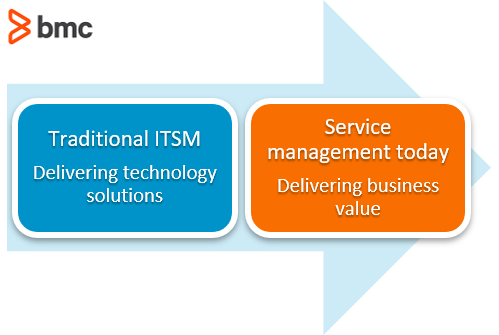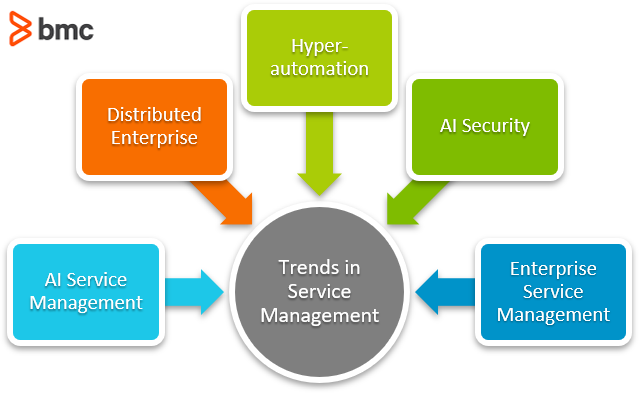Although organizations would probably like nothing more than to put the stress of the pandemic behind them, the logistical and technological changes that had to be made are something that will continue to stay around for years to come.
The IT service management space (ITSM) is no exception.
Combined with recent surveys from the past year, along with insights from industry revolutionaries and leaders, we can now get a glimpse into the future of what the service management space might look like in the coming year. From harnessing artificial intelligence and machine learning technologies, to optimizing processes already in place, here are the top ITSM trends to look out for in 2022.

Trend 1: AI-powered service management
Throughout the pandemic, businesses experienced a heightened sense of urgency surrounding the need to adopt tools that reduce the amount of manual labor required for their IT professionals.
In fact, largely due to the increase in remote work, ticket volumes in ITSM have increased by over 35% over the past year! That increase is completely unprecedented, especially compared to the historically annual ticket volume increase of 3-5% per year.
“In the face of the COVID pandemic, the enterprise ITSM sector has seen a significant increase in cost and ticket handle time that has resulted in an unprecedented decline in employee satisfaction with IT,” Sebastien Adjiman, Chief Executive of ITSM delivery optimisation company DeepCoding, said.
“It is absolutely vital that the industry responds to this wake-up call, as a failure to act could have a catastrophic impact on both internal and external customer satisfaction.”
Even though the ticket volumes grew exponentially during the pandemic, unfortunately employee hiring rates did not, quickly leading to burnout among IT staff. This leads to the question: what can companies do to manage this higher workload with a fixed number of employees?
The answer? Artificial intelligence.
One of the biggest ITSM trends of 2022, and in the entire tech space for the upcoming year, is artificial intelligence (AI). Utilizing a variety of AI technology, organizations can engage in tools that promote natural language processing (NLP), business process optimization, clustering, knowledge management, automated problem incident response, and machine learning (ML).
“For fusion teams working on AI, the real differentiator for their organizations will lie in their ability to continually enhance value through rapid AI change,” said David Groombridge, research vice president at Gartner, at the company’s annual Gartner IT Symposium/Xpo Americas conference.
“By 2025, the 10% of enterprises that establish AI-engineering best practices will generate at least three times more value from their AI efforts than the 90% of enterprises that do not.”
Artificial intelligence service management (AISM) is the application of AI to service management. AISM is an emerging approach that aims to solve the increasing challenges of traditional IT service management by focusing on:
- Proactive prevention
- Faster restoration of services
- Rapid innovation
- A fanatical focus on the employee and customer experience
A well-designed combination of AISM and AI engineering can help companies not only meet expectations for fast, accurate, and scalable services, but it can also exceed them, bringing the entire ITSM experience back to pre-pandemic efficiencies.
Trend 2: Distributed enterprise
Digital transformation isn’t a new concept, and it’s no longer an aspirational goal. The ability to operationalize and rapidly expand digital transformation has become a baseline competitive requirement for every enterprise. That means delivering consumer-grade experiences for employees and customers alike, with the ease of use, reliability, and performance people have come to expect from the best technology companies.
With millions of people around the globe still working from home, and with millions more doing so permanently, 2022 is pushing organizations to expand their digital transformation to the next level, which is the complete distributed enterprise.
By 2023, Gartner is expecting 75% of organizations that benefit from distributed enterprises to see revenue growth 25% faster than competitors, most likely replacing the traditional office-centric business environment of the past.
“This requires CIOs to make major technical and service changes to deliver frictionless work experiences, but there is another side to this coin: the impact on business models,” said Groombridge. “For every organization, from retail to education, their delivery model has to be reconfigured to embrace distributed services. The world didn’t think they’d be trying on clothes in a digital dressing room two years ago.”
ITSM processes and tools, along with their integration with other systems, will be key in building this digital, distributed enterprise.

Trend 3: Hyperautomation
The concept of hyperautomation has been one of the top ITSM trends for years, but it is a technology that continues to grow rapidly, largely driven by pandemic requirements.
“Our studies show that hyperautomation focuses on three main priorities: improving the quality of work, accelerating business processes and improving decision-making,” Groombridge continued.
Hyperautomation combines a variety of technologies, like AI, robotic process automation (RPA), and ML to automate processes in significantly more impactful ways. Companies who harness both their subject matter expertise (in all areas) and hyperautomation will:
- Improve quality
- Reduce costs
- Increase speed and productivity
- Enhance analytics, offering real-time, continuous intelligence for data-driven decision making
With the help of hyperautomation practices, IT support can finally become as strong as it aims to be. Automation is starting to take care of the low-level processes that are necessary, but don’t need the talents of IT professionals to complete them.
With the service desk losing a decent chunk of its tickets to automation, IT support will be able to utilize their valuable staff on more complex issues and critical tasks. These enhanced capabilities will only continue to improve both the end-user and customer experience—furthering the value of ITSM altogether.
(Understand how orchestration plays with automation.)
Trend 4: AI security
With technologies like AI and ML increasing in usage, it should come as no surprise that cyber criminals have quickly exploited this and found ways to compromise infrastructure. As Forbes has reported, cybercriminals are integrating AI and machine learning into their malware programs to bypass and infiltrate targeted systems.
It is crucial that ITSM organizations take security seriously and close gaps in any potential vulnerabilities—and AI security, like security analytics, can help. According to Gartner, AI security in 2022 will have three key perspectives:
- Protecting AI-powered systems. Securing AI training data, training pipelines, and ML models.
- Leveraging AI to enhance security defense. Using ML to understand patterns, uncover attacks, and automate parts of the cybersecurity processes.
- Anticipating use of AI by attackers. Identifying attacks in order to defend against them
“Data is only useful if businesses can rely on it,” said Groombridge. “But nowadays data can be stored anywhere, which means that traditional security methods no longer work. What is needed instead is a new cybersecurity mesh architecture (CSMA). By 2024, companies adopting CSMA will reduce the financial cost of security incidents by an average of 90 percent.”
As defined by Gartner, the cybersecurity mesh is a distributed architectural approach to scalable, flexible, and reliable cyber control. CSMA could help create an integrated security structure to protect all data, regardless of its location.
This is especially necessary as enterprises become more distributed and fully centralized IT becomes a thing of the past.
Trend 5: Enterprise service management
One of the final major trends that is sure to be seen in 2022 is enterprise service management. In short, enterprise service management (ESM) takes the best practices of ITSM and applies them to the entire company as a whole.
By extending the principles of service management beyond IT to the entire organization, companies can gain complete visibility into their service processes while at the same time have more access to tracking business resources, services commitments, and customer requests.
“As companies continue to face increasing uncertainty in the marketplace, those who are experience-focused and have operational agility will be the ones to keep pace with and thrive in today’s business landscape,” said Christian Lane, CEO of consulting firm Praecipio Consulting. “This requires extending ITSM capabilities and digital technologies to all teams across the organization, which is a trend we have seen play out in the digital space.”
Organizations that adopt ESM can see many benefits, including:
- Increased productivity
- Minimal waste
- Enhanced visibility and control
- Improved user satisfaction
- Sharper competitive edge
- Increased ROI
The popularity and success of ITIL® 4 has prompted other departments to utilize the same strategies outside of IT, including facilities management, accounting, finance, and Human Resources. ESM takes these strategies and uses them to improve efficiency within service design, increasing user satisfaction and supporting business needs.
The future of service management
Efficient and scalable IT service management processes are a key priority to nearly all organizations, with the global cloud ITSM market expected to grow from $4.7 billion in 2020 to over $12 billion by 2025. Both these projections and the trends of 2022 prove that ITSM is more important than ever, and industry leaders agree.
Related reading
- BMC Service Management Blog
- The State of ITSM Today
- Intelligent Knowledge-Centered Service: Essential for Modern Enterprise Success
- ITIL & ITSM Roles and Responsibilities
- 2021 Gartner® Magic Quadrant™ for ITSM Tools
- BMC Helix: SaaS Solutions for Service & Operations Management
These postings are my own and do not necessarily represent BMC's position, strategies, or opinion.
See an error or have a suggestion? Please let us know by emailing blogs@bmc.com.






